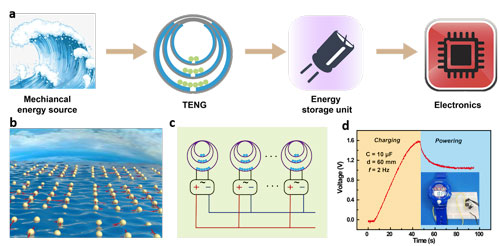| Oct 07, 2019 | |
Matryoshka-inspired hierarchically structured triboelectric nanogenerators for wave energy harvesting |
|
| (Nanowerk Spotlight) Recent extreme weather events across the world are a reminder of the possible terrible consequence of clime change, and motivate researchers to explore renewable and clean energies, such as solar energy, wind energy and wave energy for powering lights, machines and electronics. | |
| Ocean wave energy is an abundant resource of clean energy. However, having been explored for decades, there are still no efficient and economical technologies to convert water wave energy into electricity for large-scale applications. | |
| A team of researchers from Michigan State University (MSU) have developed a new type of wave energy harvester, hierarchically structured triboelectric nanogenerator (HS-TENG), based on the triboelectric effect, with the goal of harvesting ocean wave energy for large-scale deployments. | |
 |
|
| Demonstration of HS-TENGs for harvesting wave energy in the ocean and powering electronics. (a) Schematic illustration of an energy harvesting and supply system. (b) Schematic illustration of deploying large-scale HS-TENG networks in the ocean for blue energy harvesting. (c) Schematic illustration of a rectification circuit for integrating the network output. (d) Charging curve of the capacitor (10 µF) while an electronic watch is driven by the HS-TENG. The inset is a photograph of the watch connected with the HS-TENG. (click on image to enlarge) | |
| The wave energy converter HS-TENG is inspired by matryoshka dolls, also called 'stacking dolls', which have multiple wooden layers of a decreasing size. The HS-TENG is nest-assembled by multiple layers of shells with decreasing sizes, opening the door for a new kind of TENG with low-cost, high power density and high efficiency. | |
| The innovative hierarchical structure in HS-TENG can effectively improve the space utilization and output performance of traditional single-balled TENGs, paving the way for developing next-generation high-performance TENGs for blue energy harvesting. | |
| The findings are being reported in the journal Nano Energy ("Matryoshka-inspired hierarchically structured triboelectric nanogenerators for wave energy harvesting") in a paper by Changyong Cao, Assistant Professor at MSU School of Packaging, with postdoc Yaokun Pang, graduate student Shoe Chen, Yihang Chu, and Prof. Zhong Lin Wang from Georgia Institute of Technology. | |
| "Currently, most energy harvesters for capturing water wave energy are based on electromagnetic generator machines (EGMs)," said Dr. Yaokun Pang, the lead author of the paper. "They have the drawbacks of complex design, high cost and ease of corrosion in seawater. However, the new triboelectric nanogenerators could efficiently harvest low-frequency and irregular mechanical energy from the surrounding environment, such as from vibration, walking, wind, water wave, and even heart beating." | |
| “TENG has emerged as a powerful technology for harvesting mechanical energy,” says Dr. Changyong Cao, the principal investigator of the project and director of the MSU’s Laboratory of Soft Machines and Electronics (SME). “Our efforts are geared towards inventing new approaches for maximizing the output performance of TENGs.” | |
| The researchers got their inspiration from the Matryoshka Doll, which is a set of wooden Russian dolls of different sizes, designed so that each one fits inside the next. They hypothesized that this kind of hierarchical structure can be borrowed for the design of TENGs to increase the space utilization in energy harvesting. | |
| In this work, to identify a more efficient HS-TENG structure, they have studied in detail the influence of the size and number of smaller moving balls on the energy harvesting performance of the HS-TENG. Then, the output performance of a single HS-TENG unit is also characterized and optimized based on the amplitude, frequency and orientation angle of the wave actuation for enhancing its energy harvesting performance. | |
| Finally, the researchers fabricated a HS-TENG array network to investigate the possibility of harvesting ocean wave energy on a large scale. They demonstrated that a 3x3 array can power dozens of light-emitting diodes (LEDs) and power an electronic thermometer for monitoring water conditions. | |
| “There are still many challenges to be solved for applying this technology in large scale applications,” says Cao. “With sufficient investment and technological support, I believe that the TENG networks in the future may generate enough electricity to power a city or even a country.” | |
|
Provided by Michigan State University as a Nanowerk exclusive
|
|
|
Become a Spotlight guest author! Join our large and growing group of guest contributors. Have you just published a scientific paper or have other exciting developments to share with the nanotechnology community? Here is how to publish on nanowerk.com. |
|
